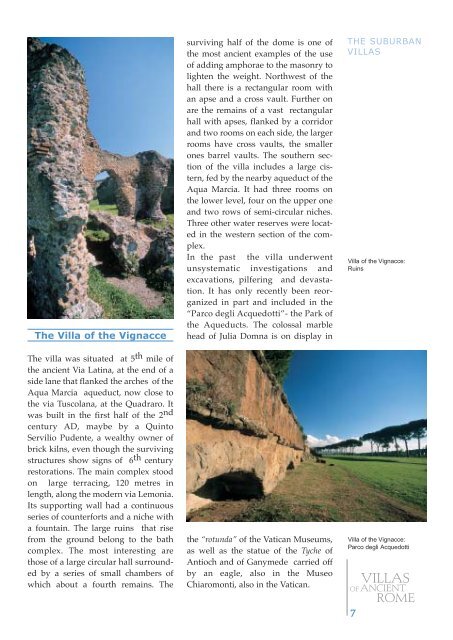Create successful ePaper yourself
Turn your PDF publications into a flip-book with our unique Google optimized e-Paper software.
The Villa <strong>of</strong> the Vignacce<br />
The villa was situated at 5 th mile <strong>of</strong><br />
the ancient Via Latina, at the end <strong>of</strong> a<br />
side lane that flanked the arches <strong>of</strong> the<br />
Aqua Marcia aqueduct, now close to<br />
the via Tuscolana, at the Quadraro. It<br />
was built in the first half <strong>of</strong> the 2 nd<br />
century AD, maybe by a Quinto<br />
Servilio Pudente, a wealthy owner <strong>of</strong><br />
brick kilns, even though the surviving<br />
structures show signs <strong>of</strong> 6 th century<br />
restorations. The main complex stood<br />
on large terracing, 120 metres in<br />
length, along the modern via Lemonia.<br />
Its supporting wall had a continuous<br />
series <strong>of</strong> counterforts and a niche with<br />
a fountain. The large ruins that rise<br />
from the ground belong to the bath<br />
complex. The most interesting are<br />
those <strong>of</strong> a large circular hall surrounded<br />
by a series <strong>of</strong> small chambers <strong>of</strong><br />
which about a fourth remains. The<br />
surviving half <strong>of</strong> the dome is one <strong>of</strong><br />
the most ancient examples <strong>of</strong> the use<br />
<strong>of</strong> adding amphorae to the masonry to<br />
lighten the weight. Northwest <strong>of</strong> the<br />
hall there is a rectangular room with<br />
an apse and a cross vault. Further on<br />
are the remains <strong>of</strong> a vast rectangular<br />
hall with apses, flanked by a corridor<br />
and two rooms on each side, the larger<br />
rooms have cross vaults, the smaller<br />
ones barrel vaults. The southern section<br />
<strong>of</strong> the villa includes a large cistern,<br />
fed by the nearby aqueduct <strong>of</strong> the<br />
Aqua Marcia. It had three rooms on<br />
the lower level, four on the upper one<br />
and two rows <strong>of</strong> semi-circular niches.<br />
Three other water reserves were located<br />
in the western section <strong>of</strong> the complex.<br />
In the past the villa underwent<br />
unsystematic investigations and<br />
excavations, pilfering and devastation.<br />
It has only recently been reorganized<br />
in part and included in the<br />
“Parco degli Acquedotti”- the Park <strong>of</strong><br />
the Aqueducts. The colossal marble<br />
head <strong>of</strong> Julia Domna is on display in<br />
the “rotunda” <strong>of</strong> the Vatican Museums,<br />
as well as the statue <strong>of</strong> the Tyche <strong>of</strong><br />
Antioch and <strong>of</strong> Ganymede carried <strong>of</strong>f<br />
by an eagle, also in the Museo<br />
Chiaromonti, also in the Vatican.<br />
THE SUBURBAN<br />
VILLAS<br />
Villa <strong>of</strong> the Vignacce:<br />
Ruins<br />
Villa <strong>of</strong> the Vignacce:<br />
Parco degli Acquedotti<br />
VILLAS<br />
OF ANCIENT<br />
7<br />
ROME

















